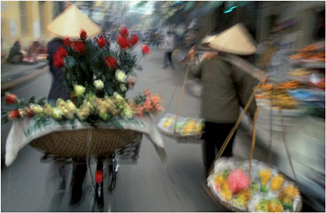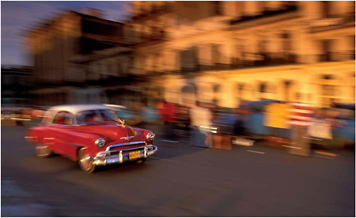Motion
Life often seems a bit of a blur. Much as we’d all like to slow things down now and then we’re all whizzing about, and so is the world around us. Waves lap, trees lean, clouds drift, birds flutter, leaves scatter, grass sways, water ripples, wind gusts, sheep graze, people stride and the sun rises – the world is a busy place. A photograph must somehow convey that motion, to not do so usually results in a somewhat sterile take on the world.
Photographers have a choice; to blur or not to blur, that is the question. Using fast shutter speeds we can freeze all movement, or go slow and everything becomes a bit fuzzy; lock the camera off on the tripod while the world swirls around it, or have the camera moving as well. If it’s the latter then the slower the shutter speed the more surreal, even impressionistic, the image becomes. I use motion in pictures to suggest speed, or to emphasize the bustle of a busy market or street scene.
“To blur or not to blur, that is the question”
How much motion is evoked is dependent on the shutter speed, the velocity at which the subject is moving and the amount of panning; it’s a complex relationship that is best perfected with trial and error. Typically, for a cyclist whizzing past along a Dutch canal I’d use a shutter speed of about 1/8sec. Of course, the beauty of shooting digitally is you can fine-tune the amount of motion blur with just a few test shots. But whether

Dusk on the Lizard Peninsula, Cornwall, England
It’s late on a winter’s afternoon and I’m standing counting off the time in the middle of an eight-minute exposure with the waves lapping around my feet. The tide is coming in and after this exposure I’ll have to up sticks and move up the beach to avoid a soggy camera situation. It’s a risky set up; one large wave and several thousand pounds’ worth of equipment is history. I’m using a neutral density filter to slow down the exposure. There’s movement in the water and in the sky as the clouds pile in off the Atlantic. The light has got a steely, cold, grey quality, with the setting sun weakly piercing the clouds to the west to give a few heavenly shafts. The movement in the sea and sky is emphasized by the sharp detail in the sculpted rocks and ship on the horizon. Standing looking at this scene with the naked eye it all looks very different from how the finished picture will look; but that is all part of developing a photographer’s vision. And heavenly shafts always help.
• Fuji GX617, 90mm lens

Street scene, Hanoi, Vietnam
The alleys of Hanoi are a whirlwind of unfeasibly loaded bicycles, market stalls and women in conical hats – it’s intoxicating. I spend several days engrossed in the mayhem, panning and working quickly handheld, revelling in the culture shock. The women with the hats and baskets of produce are the icons this time, and the bustle of Hanoi can only be conveyed with motion. In this case everything is moving, the ladies with the flowers and vegetables, the camera and me. They come past me and I slot in behind and up close long enough to squeeze off a few frames before they become aware of me and stop in bemusement. There’s nothing sharp, but the blur makes for an almost impressionistic feel. Here the background distractions are lost in a wonderful fudgy blur, and that’s before a beer or two.
• Nikon F5 17–35mm lens
using film or digital a few trial runs practising this useful technique and noting the results in controlled circumstances are well worth the time and effort. Nine times out of ten there’s something moving somewhere in my frame, and I often go to great lengths to accentuate that movement. I stop down to the minimum aperture and use neutral density filters to slow the exposure as much as possible. I’ve spent significant tracts of my life waiting for a waft of breeze to sway the grass in the foreground, or the one in a hundred wave to crash on the rocks – more waiting, as if there wasn’t enough already. In a landscape, movement can add mood and interest. In a street scene it can do the same with the added bonus of masking unsightly details; litter strewn on streets becomes bright streaks of colour, as do garish advertising hoardings and all the other detritus of life. Emphasizing motion is yet another tool in a photographer’s arsenal, a vital element in the making of a picture.

Passing car, Havana, Cuba
Among the most visible icons of Cuba are the 1950s cars. Another aspect of Havana’s old town is the fading elegance of the colonial architecture, slightly decrepit but atmospheric nonetheless, and I want to combine these two elements in an image that just says ‘Cuba’. The trouble is, up close a lot of the details of Habana Vieja are fairly grotty – ugly cabling, litter, mangy dogs and lots of tourists. So it’s going to have to be a panning shot: the movement will convey the bustle of the place while losing some of the distracting details. Finding the right background was critical. I trudged around the city fending off the hustlers and hookers looking for the right buildings, ones that would look good with a bit of blur and evening light. So, here I am all set with the old Buicks trundling past and soft golden rays bathing the buildings behind. Getting a smooth panning action is the key – it takes some practice.
• Nikon F5, 24–70mm lens
